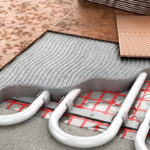Which warm floor is better for tiles?
 To make their home more comfortable, many decide to install underfloor heating. What features does each of the heated floor options have? Which one is better to install under tiles?
To make their home more comfortable, many decide to install underfloor heating. What features does each of the heated floor options have? Which one is better to install under tiles?
The content of the article
Pros and cons of different types of underfloor heating systems under tiles
There are several types of underfloor heating systems, each of them has its own advantages and disadvantages.
Water heated floor
The structure of this system consists of polymer pipes placed in a concrete or wood floor covering. Its job is to heat these pipes from the general heating system or individual heating, as a result of which heat is created.
ATTENTION! This option is not suitable for installing heating in apartments, as this is fraught with an accident due to incorrect connection or installation.
When installing, you must follow the basic rules:
- in your own home, you can use any heating system to install a warm water floor, but in an apartment it is better to connect it to a gas boiler, since the general heating may not withstand such a load;
- It is better to entrust installation to professionals if you are not confident in your abilities;
- the entire structure requires a fairly thick screed;
- It is recommended to install water heated floors in rooms with a large area;
- when choosing a system, you should not skimp on it, since at the slightest breakage you will have to break the screed completely;
- The power of the gas boiler must withstand the load of all systems.
REFERENCE! During use, turning the water heating system on and off occurs for the entire room, and not just some part of it.
This type is durable and economical to use, but is suitable for those premises in which people live permanently. To prevent the water in the pipes from freezing during low temperatures, antifreeze is poured into them.
Electrical cable
This type of insulation is very easy to assemble - lay the electrical cable in the form of a snake on a thermally insulated surface with a reflector and fix it.
IMPORTANT! The tie should be about 40 cm thick so that the cable is not damaged.
Then everything is covered with tiles, which are laid with glue. This type is very convenient for installation, since you can bypass all obstacles: pipes, toilet bowl, etc.
Heating mats
Heating mats are an electrical system, which, unlike the previous option, speeds up the installation process. The electrical wire is already attached to the grid and does not need to be installed manually.
The advantage of this system is that this mesh can cover the entire area of the room or partially. It is also very easy to install it yourself, without any skills.
Film system
This type of heating system works using the infrared spectrum and can simply be laid under a carpet, linoleum or any other floor covering. Heat transfer is uniform.
Its structure consists of a polymer heating film (0.4 mm high), a temperature device, and a thermostat. The advantage of such a heating system is that during its operation, you can set a certain operating mode using a temperature controller. Also, during heating, it forms a magnetic field, which does not affect human health in any way, which is very important.
Installation is simple. Difficulty may arise only with the quality of adhesion of the glue and the heated floor, but this problem can be solved by first laying a fiberglass mesh or gypsum fiber sheet under the tiles.
Electric water heating
The electric water system is a structure made of polyethylene pipes, the diameter of each of them is about 20 mm, laid in a concrete screed. It also contains anti-freeze fluid and a nickel-chromium alloy heating cable coated with Teflon. If the pipeline is in a faulty condition, then the non-freezing liquid will appear on the floor covering at the site of damage. This is one of the advantages of this heating.
As practice has shown, electric water floors consume little electricity. Using the temperature controller, you can set the desired temperature. Thanks to the non-freezing liquid, energy consumption is insignificant.
When heat reaches the non-freezing liquid, it begins to boil within a short period of time. Then the floor heats up very quickly, and the heat remains for a very long time. This type of heating allows you to consume a minimum of electricity with maximum efficiency.
What type of underfloor heating is best to choose for tiles?
Of course, each option is good in its own way, but the choice of heating type depends on where you plan to install heated floors.
If you are interested in economical options, then these include: water floor and electric water systems. The advantage of the first is that it can be connected to individual heating, and the second heating system will save your energy costs.
As practice has shown, film floors are not the best heating option for laying under tiles.

